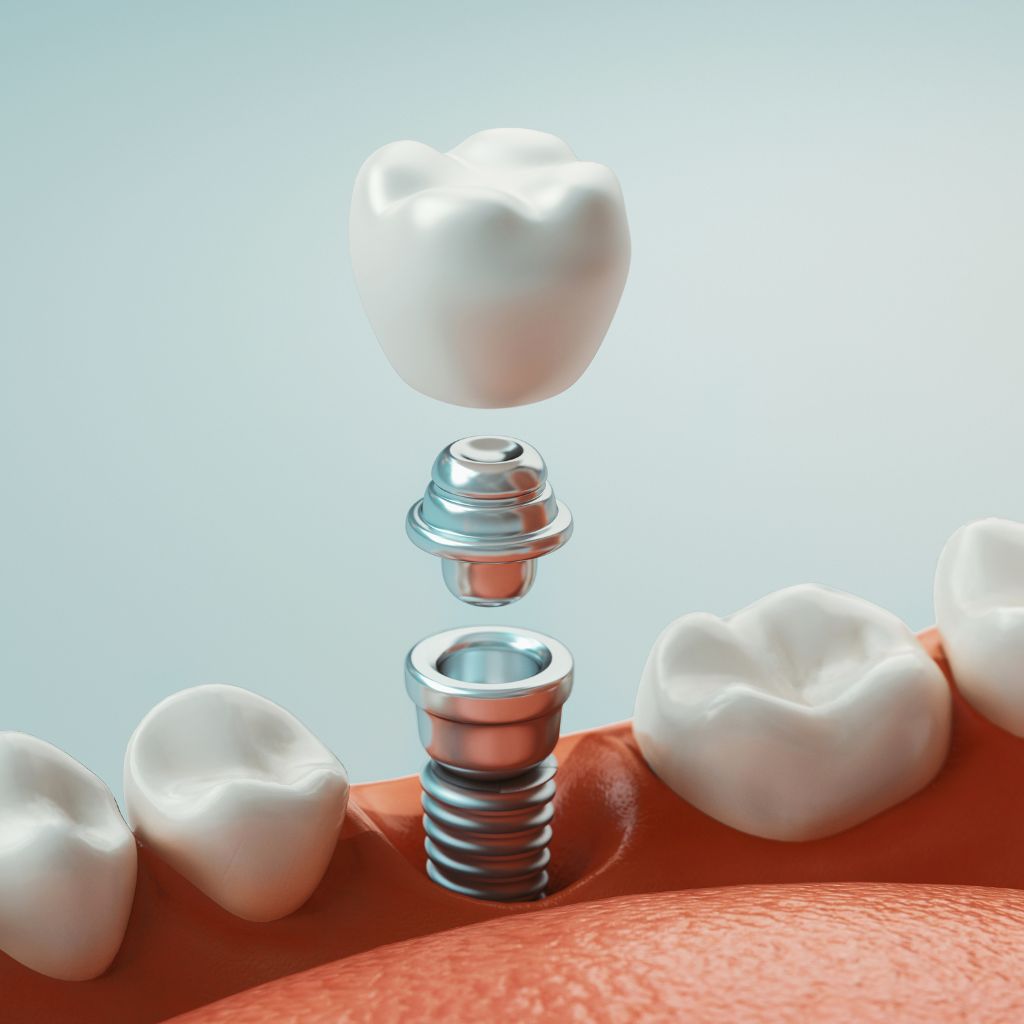Discovering that your dental implant crown feels loose can be concerning. Understanding the warning signs and knowing what steps to take can help you address the issue promptly and effectively. At Dental Specialties Northwest, we frequently see patients concerned about potential implant crown problems, and proper identification is the first step toward resolution.
How to Identify a Loose Dental Implant Crown
A dental implant crown consists of three main components: the implant (a titanium post surgically embedded in your jawbone), the abutment (a connector piece), and the crown (the visible tooth-like restoration). When functioning properly, these components work together seamlessly. However, sometimes the crown or other components can loosen, leading to noticeable symptoms.
Physical Movement and Instability
The most obvious sign of a loose dental implant crown is movement when you touch it with your tongue or finger. You might notice this instability particularly when chewing food or brushing your teeth. To safely test for movement, gently apply pressure to the crown using your finger—any wiggling or rocking sensation indicates looseness. You might also observe visible gaps between the crown and your gum line, which weren’t present before.
Research indicates that approximately 7.2% of dental implants experience screw loosening issues, with single crowns having a higher loosening rate of around 14%. This makes movement the primary indicator that something isn’t right with your restoration.
Pain and Discomfort When Chewing
A loose implant crown often causes pain or discomfort, especially during meals. This pain can vary widely—from sharp, sudden pain when biting down to a dull, persistent ache around the implant site. Some patients describe it as a pressure sensation when chewing certain foods.
Unlike normal post-implantation discomfort (which gradually diminishes after placement), pain from a loose crown typically emerges after the implant has been stable and comfortable. The discomfort may worsen with harder foods or when applying pressure directly to the crown. If you find yourself avoiding chewing on one side of your mouth, this could indicate a loose implant crown.
Unusual Sounds or Sensations
Another telltale sign is hearing clicking or popping sounds when you chew or speak. These noises result from movement between components that should be firmly connected. Additionally, you might experience unusual sensations such as a metallic taste in your mouth (which can indicate metal components rubbing together) or persistent bad breath despite maintaining good oral hygiene.
Some patients report food becoming trapped under or around the crown more frequently than before, which can cause irritation to the surrounding gum tissue and contribute to inflammation around the implant site.
Why Dental Implant Crowns Come Loose
Understanding the underlying causes of a loose implant crown helps determine the appropriate solution. Various factors can contribute to this issue, and different parts of the implant system may be affected.
Loose Abutment Screw
The most common mechanical problem occurs when the abutment screw connecting the crown to the implant becomes loose. This typically results from regular biting forces or parafunctional habits like teeth grinding (bruxism). When you bite down, forces are transmitted through the crown to the abutment and implant.
Research shows that parafunctional habits increase the risk of loosening by approximately 30%. Additionally, non-axial loading (forces that don’t align with the implant’s long axis) accounts for about 35% of loosening cases. Daily chewing generates thousands of micro-movements that can gradually loosen the screw over time, especially if your bite isn’t perfectly aligned.
Cement Failure Between Crown and Abutment
For cement-retained crowns, the bond between the crown and abutment can deteriorate. This failure happens due to several factors:
- Natural breakdown of dental cement over time
- Trauma or impact to the crown
- Improper initial fit during placement
- Saliva contamination during the cementation process
- Inadequate cement application
When cement fails, the crown may remain in place but feel loose when pressure is applied. You might notice a slight gap forming between the crown and gum tissue or experience sensitivity when consuming hot or cold foods.
Bone Loss and Implant Instability
A more serious cause of crown loosening involves the implant itself becoming unstable due to bone loss. This condition, known as peri-implantitis (a form of gum disease affecting implants), can compromise the foundation supporting your implant.
Signs of this more severe problem include:
- Redness and swelling of the surrounding gum tissue
- Bleeding when brushing around the implant
- Pus discharge around the implant site
- Gradual sinking or shifting of the entire restoration
- Persistent bad breath despite good hygiene
Bone loss can result from poor oral hygiene, smoking, uncontrolled diabetes, or excessive biting forces over time. This condition requires prompt professional attention to prevent further deterioration.
Emergency Actions for a Loose Dental Implant Crown
When you notice your implant crown is loose, taking appropriate action quickly can prevent additional complications. While not always requiring same-day emergency care, most issues should be addressed within 48 hours to avoid further damage.
Immediate Steps to Take at Home
If you discover your implant crown is loose, here are practical steps to manage the situation before seeing your dentist:
- Avoid chewing on the affected side completely, even with soft foods
- Keep the area clean by gently rinsing with warm salt water (½ teaspoon salt in 8 ounces of water)
- Don’t attempt to glue or fix the crown yourself—temporary dental cement can damage components and complicate professional repair
- If the crown completely detaches, store it in a clean container and bring it to your appointment
- Take over-the-counter pain relievers like acetaminophen if experiencing discomfort
- Avoid probing or manipulating the crown, which can cause further loosening or damage
These measures help protect the implant components until professional care is available.
When to Seek Emergency Dental Care
While a loose crown often allows some scheduling flexibility, certain situations warrant immediate professional attention:
- Severe pain that interferes with daily activities or sleep
- Signs of infection (facial swelling, fever, pus discharge)
- Complete detachment of components, especially if the abutment or implant is exposed
- Sharp edges causing injury to your tongue or cheek
- Difficulty breathing or swallowing (rare but serious)
Most dental practices, including ours at Dental Specialties Northwest, maintain emergency appointment slots for urgent situations. Don’t hesitate to call if you’re experiencing any of these symptoms.
Professional Treatment Options
Treatment for a loose implant crown depends on identifying the specific component causing the problem. A comprehensive examination, often including x-rays, helps determine the appropriate course of action.
Tightening or Replacing the Abutment Screw
If the abutment screw is loose but undamaged, your dentist can access and tighten it. This procedure typically involves:
- Removing the crown (if it’s screw-retained, an access hole is used; for cement-retained crowns, the crown must be carefully removed)
- Cleaning the screw and internal components
- Torquing the screw to the manufacturer’s specifications using a calibrated wrench
- Sealing the access hole with composite material or recementing the crown
This relatively straightforward procedure often resolves the issue completely. In some cases, a new screw may be required if the original shows signs of wear or damage.
Crown Recementation or Replacement
When the crown itself is the problem, your dentist might:
- Recementation: If the crown is undamaged and properly fitted, it can be professionally cleaned and reattached using new cement
- Replacement: If the crown is damaged, worn, or poorly fitted, a new one will be fabricated
The success of repair attempts largely depends on the nature of the problem. Mechanical issues like loose abutments or minor fractures typically respond well to repair, while cases involving implant body damage, failed osseointegration, or extensive bone loss may require replacement of the entire restoration.
Addressing Underlying Bone or Tissue Issues
More complex cases involving bone loss or inflammation require comprehensive treatment:
- Professional cleaning around the implant (known as debridement)
- Antibiotic therapy (local or systemic) to control infection
- Bone grafting procedures to restore lost bone
- In severe cases, removal and replacement of the implant after healing
Recovery from these procedures varies depending on the extent of the issue, but most patients can expect several months of healing for bone regeneration treatments.
Preventing Future Implant Crown Loosening
Proactive maintenance significantly reduces the risk of future implant complications. Prevention is always preferable to repair, both clinically and financially.
Proper Oral Hygiene Practices
Maintaining excellent oral hygiene is crucial for implant longevity:
- Brush twice daily using a soft-bristled or oscillating electric toothbrush
- Clean around implants carefully, angling the brush toward the gumline
- Use implant-specific floss or water flossers to clean beneath and around the crown
- Consider antimicrobial mouth rinses as recommended by your dentist
- Clean any removable appliances (like night guards) regularly
Research confirms that patients who maintain meticulous oral hygiene experience significantly fewer implant complications over time.
Regular Dental Check-ups and Maintenance
Professional monitoring plays a vital role in implant health:
- Schedule regular check-ups every 4-6 months
- Allow your dentist to perform professional cleanings around implants
- Undergo periodic x-rays to evaluate bone levels and implant integrity
- Have your bite (occlusion) checked regularly to ensure proper force distribution
During these appointments, your dentist can identify and address minor issues before they develop into major problems requiring extensive treatment.
Lifestyle Adjustments to Protect Your Implant
Certain lifestyle modifications can significantly extend the lifespan of your implant restoration:
- Wear a custom nightguard if you grind or clench your teeth
- Avoid using your teeth as tools (opening packages, biting fingernails, etc.)
- Limit consumption of extremely hard foods like ice, hard candies, or nuts
- Quit smoking, as it significantly increases implant failure rates
- Manage underlying health conditions like diabetes that affect bone health
By implementing these protective measures, you can enjoy your dental implant restoration for many years to come.
Frequently Asked Questions About Loose Dental Implant Crowns
How Much Does Fixing a Loose Implant Crown Cost?
The cost of repairing a loose implant crown varies depending on the underlying issue:
- Simple tightening of an abutment screw: $150-$400
- Crown recementation: $200-$350
- New crown fabrication: $800-$2,500
- Treatment for peri-implantitis: $500-$2,500+
Most dental insurance plans provide partial coverage for implant maintenance and repair, though coverage percentages vary widely. At Dental Specialties Northwest, we work with patients to maximize insurance benefits and explore financing options when needed.
Can a Loose Implant Crown Fix Itself?
No, a loose dental implant crown will not fix itself. In fact, delaying treatment typically leads to more extensive and expensive problems:
- Continued loosening can damage internal components
- Bacterial infiltration beneath a loose crown can cause infection
- Untreated bone loss progresses, potentially leading to complete implant failure
Professional intervention is always necessary to address the underlying cause and restore proper function.
Is Implant Crown Loosening Covered by Dental Insurance?
Most dental insurance plans provide some coverage for implant-related repairs, though coverage varies significantly:
- Diagnostic visits and x-rays: Typically 80-100% covered
- Repair procedures: Generally 50-80% covered
- Replacement components: Often 50% covered, subject to annual maximums
- Major reconstructive procedures: Usually limited coverage with higher out-of-pocket costs
It’s important to verify your specific policy details with your insurance provider or have your dental office help determine your coverage before proceeding with treatment.
Schedule Your Implant Assessment Today
Experiencing a loose dental implant crown can be concerning, but prompt attention can prevent more serious complications. The good news is that most implant-related issues can be successfully treated when addressed early. Following proper maintenance protocols and seeking professional care at the first sign of problems significantly improves long-term outcomes.
At Dental Specialties Northwest, our team specializes in dental implant maintenance and repair. We provide comprehensive evaluations to identify the specific cause of your loose crown and develop personalized treatment plans to restore your smile’s health and appearance. Contact our office at (206) 682-8200 or visit our contact page to schedule your assessment today.



